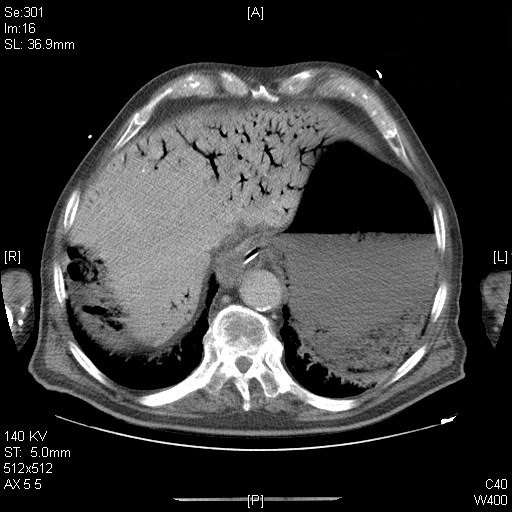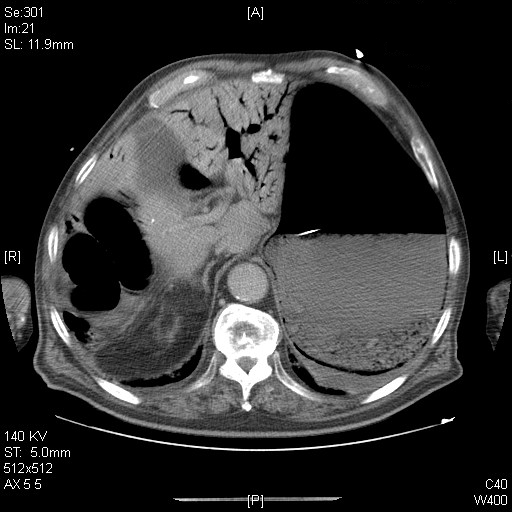We present a case of an 85-year-old man, admitted in the emergency room with respiratory distress, associated with aspiration pneumonitis, as result of heavy vomiting, probably due to an acute abdomen. The patient presented exuberant abdominal distension, with no abdominal sounds. The arterial blood gas analysis showed a severe lactic acidosis and the abdominal X-ray image revealed gastric and intestinal distension.
After initial approach, abdominal angio-CT was promptly performed, with the diagnosis of Intestinal Ischemia. CT also showed severe gastric distension and significant venous portal gas, with peripheral distribution, throughout the liver. From the onset, the patient presented a poor prognosis, dying shortly after.
Hepatic portal venous gas (HPVG) is a rare condition, resulting from the accumulation of gas in the portal vein and its branches, a differential diagnosis of Aerobilia, in which air is found in the biliary tree, with a central distribution. HPVG can be related to intestinal ischemia or necrosis (43%)1, inflammatory bowel disease, perforated peptic ulcer, bowel luminal distention (iatrogenic, barotrauma, etc.), intra-abdominal sepsis, among other benign non-surgical diseases2. When first described by Wolfe and Evans, in 19553, HPVG was associated with high mortality rates (up to 75%)4. Recent literature shows that mortality is not directly related to the presence of gas in the hepatic tissue, but to its cause. Over time, the greater accessibility to abdominal CT, allowed the early diagnosis of surgical and non-surgical diseases2 associated with HPVG and, therefore, an accentuated decrease in mortality of these patients, between 29 and 39%5. This reduction is also related to the greater success rate of treatments of the various etiologies behind HPVG5. However, HPVG continues to be identified in patients with greater severity of the clinical status, with higher mortality rate.6
Figura I

Abdominal Angio Computed Tomography Scan
Figura II

Abdominal Angio Computed Tomography Scan
BIBLIOGRAFIA
1. Kinoshita H, Shinozaki M, Tanimura H, et al. Clinical features and management of hepatic portal venous gas: four case reports and cumulative review of the literature. Arch Surg. 2001;136(12):1410-1414
2. Nelson AL, Millington TM, Sahani D, Chung RT, Bauer C, et al. Hepatic Portal Venous Gas, The ABCs of Management. Arch Surg. 2009;144(6):575-581.
3. Wolfe JN, Evans WA. Gas in the portal veins of the liver of infants: a roentgenographic demonstration with postmortem anatomical correlation.Am J Roentgenol Radium Ther Nucl Med.1955;74(3):486–8
4. Liebmann PR, Patten MT, Manny J, Benfield JR, Hechtmann HB. Hepatic-portal venous gas in adults: etiology, pathophysiology and clinical significance.Ann Surg.1978;187(3):281–7.
5. McElvanna K, Campbell A, Diamond T. (2012). Hepatic portal venous gas - three non-fatal cases and review of the literature. Ulster Med J 2012;81(2):74-78.
6. T. P. Howard, S. Pittman, R. Gullipalli, A. Hartery. The Prognostic Value of Portal Venous Gas on CT: An Analysis of Six Cases. Poster presented in E CR 2015. 10.1594/ecr2015/C-1759



